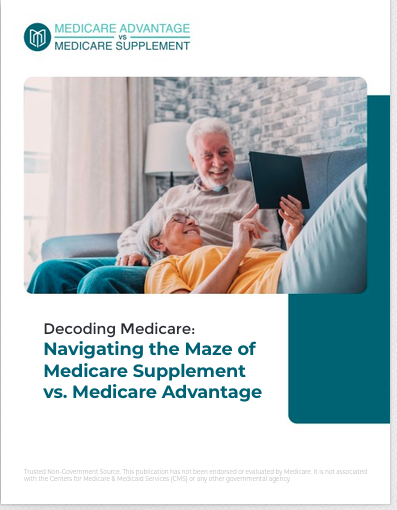Key Takeaways
-
Understanding Medicare coverage options: Medicare Advantage combines hospital, medical, and often prescription coverage, while Medicare Supplement plans only complement Original Medicare.
-
Cost differences: Premiums, deductibles, and co-pays vary significantly between Medicare Advantage and Medicare Supplement plans, influencing your overall healthcare costs.
Medicare Choices Made Simple
Choosing the right Medicare plan is essential for maintaining your health and financial stability as you age. But with Medicare Advantage, Original Medicare, supplemental coverage, and prescription drug plans, it’s easy to feel overwhelmed. This article clears up confusion about two popular paths: Original Medicare with supplemental insurance (Medigap) and Medicare Advantage (Part C).
Let’s dive into the key differences so you can make a confident choice.
The Medicare Basics You Should Know
Before we dive deep, let’s quickly recap what Medicare covers:
-
Medicare Part A covers inpatient hospital stays, skilled nursing facility care, hospice care, and some home health care.
-
Medicare Part B covers outpatient care, preventive services, doctor visits, and diagnostic tests.
-
Medicare Part D provides prescription drug coverage.
When people talk about “Medicare plans,” they’re often comparing Medicare Advantage (Part C) and Medicare Supplement (Medigap) policies. Here’s a detailed breakdown:
Medicare Advantage (Part C): What You Need to Know
Medicare Advantage plans replace Original Medicare by bundling Parts A, B, and usually D into a single, convenient plan managed by private insurers. Here’s what you should consider about Medicare Advantage:
How Medicare Advantage Works
Medicare Advantage plans are offered by private insurance companies approved by Medicare. When you enroll in Medicare Advantage, your healthcare coverage comes directly through that private insurer instead of original Medicare. These plans must provide at least the same level of coverage as Original Medicare Parts A and B, often with extra benefits.
Types of Medicare Advantage Plans
Most Medicare Advantage plans are structured as HMOs (Health Maintenance Organizations) or PPOs (Preferred Provider Organizations):
-
HMO Plans require you to use a network of healthcare providers, except in emergencies. You must choose a primary care doctor and get referrals for specialists.
-
PPO Plans give you more flexibility in choosing doctors, specialists, and hospitals. You typically pay less when using providers within the plan’s network.
-
Special Needs Plans (SNPs) focus specifically on individuals with chronic conditions or those eligible for both Medicare and Medicaid.
Costs of Medicare Advantage
Medicare Advantage plan costs vary by provider, location, and the specific coverage details. You’ll typically have:
-
A monthly premium in addition to your Part B premium ($185 per month in 2025).
-
Out-of-pocket costs including copays or coinsurance for doctor visits and hospital stays.
-
An annual out-of-pocket maximum ($9,350 for in-network and up to $14,000 combined for in and out-of-network).
Remember, costs can fluctuate based on the specific Medicare Advantage plan you choose.
Pros of Medicare Advantage Plans
Medicare Advantage plans can be appealing because:
-
Many include additional benefits like dental, vision, hearing, or wellness programs.
-
Prescription drug coverage is often bundled, simplifying healthcare management.
-
There’s a cap on annual out-of-pocket expenses, which limits your financial risk.
However, provider networks can limit your healthcare choices. You must verify that your preferred doctors or hospitals participate in the plan’s network.
Medicare Supplement (Medigap): What You Need to Know
Medicare Supplement Insurance (Medigap) helps fill “gaps” in Original Medicare coverage. Medigap plans are standardized and identified by letters (Plans A through N), each offering different levels of coverage.
How Medigap Plans Work
Medigap policies cover out-of-pocket expenses that Original Medicare doesn’t fully pay, such as deductibles, coinsurance, and copayments. You pay a monthly premium for Medigap, in addition to the Medicare Part B premium.
Coverage Provided by Medigap
Medigap typically covers:
-
Medicare Part A coinsurance and hospital costs (up to an additional 365 days after Medicare benefits run out).
-
Medicare Part B coinsurance or copayments.
-
Blood transfusions (first 3 pints).
-
Part A hospice care coinsurance or copayment.
-
Skilled nursing facility care coinsurance.
-
Foreign travel emergency coverage (in certain plans).
It’s important to note that Medigap policies sold after January 1, 2020, can’t cover the Medicare Part B deductible ($257 in 2025).
How Costs Work with Medigap
With Medigap, your costs include:
-
A monthly premium determined by the insurance provider, your age, and geographic location.
-
Your Medicare Part B premium ($185 per month in 2025).
-
Little or no additional out-of-pocket costs for covered services, depending on your chosen plan.
Medigap provides predictable out-of-pocket expenses, making budgeting easier, but monthly premiums can increase over time as you age.
Flexibility of Medigap Plans
Medigap allows you to see any doctor who accepts Medicare. Unlike Medicare Advantage, there are no network restrictions. This flexibility can be appealing if you frequently travel or prefer unrestricted choice of healthcare providers.
Medicare Advantage vs. Medicare Supplement: Making Your Decision
When comparing Medicare Advantage and Medigap, you should focus on your lifestyle, health needs, budget, and personal preferences:
Reason #1: Coverage Flexibility
-
Choose Medicare Advantage if you’re comfortable with network restrictions for potentially lower premiums and added benefits.
-
Choose Medigap if freedom to select any Medicare-accepting healthcare provider matters most.
Reason #2: Cost Certainty
-
Medicare Advantage plans limit your annual out-of-pocket expenses, offering predictability once you reach the annual maximum.
-
Medigap plans help lower or even eliminate most out-of-pocket healthcare costs, but require predictable monthly premiums.
Reason #3: Prescription Drug Needs
-
Medicare Advantage often includes prescription drug coverage, simplifying your healthcare management.
-
Medigap doesn’t cover prescription drugs. You’ll need a standalone Medicare Part D plan for medication coverage.
Reason #3: Plan Availability
-
Medicare Advantage plans vary significantly by geographic region, meaning fewer options in rural areas.
-
Medigap plans tend to be more widely available across the country, though premiums can vary greatly by region.
Reason #4: Long-Term Considerations
-
Medicare Advantage plans might change their benefits, networks, or costs annually. You should review your Annual Notice of Change carefully each year during Open Enrollment (October 15 to December 7).
-
Medigap plans offer more stability, as benefits rarely change once you’re enrolled.
Your Next Steps in Medicare Planning
When you reach Medicare eligibility (typically age 65), you have a seven-month Initial Enrollment Period (IEP) beginning three months before your 65th birthday, your birth month, and ending three months after. Missing this window can lead to penalties or coverage delays.
Additionally, the Annual Enrollment Period from October 15 to December 7 each year allows existing Medicare beneficiaries to reassess their coverage options. It’s essential to review your coverage annually since Medicare Advantage plans frequently change.
Getting Expert Medicare Advice Is Key
Medicare decisions can significantly impact your finances, healthcare choices, and overall quality of life in retirement. It’s essential to choose wisely based on your healthcare needs, budget, and lifestyle.
To make the most informed decision possible, consider speaking with a licensed Medicare agent who can help you navigate options tailored to your unique circumstances. A professional can clarify your choices, helping you select a plan that fits your budget, coverage preferences, and peace of mind.
For personalized help in making your Medicare decision, connect with a licensed agent listed on our website today.










